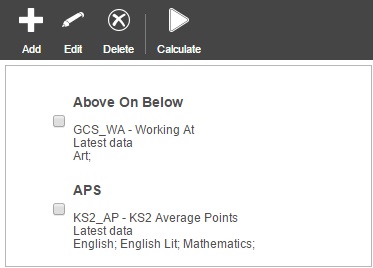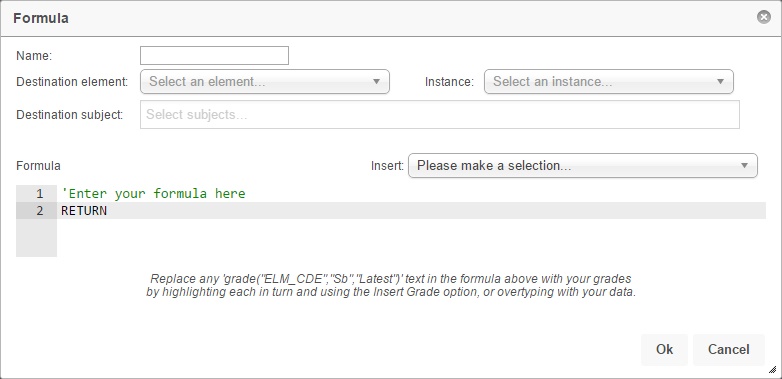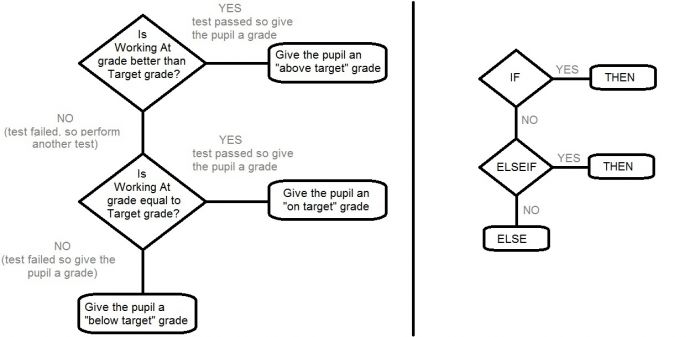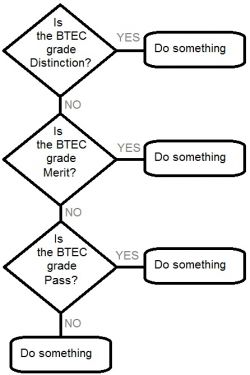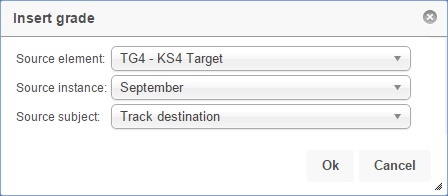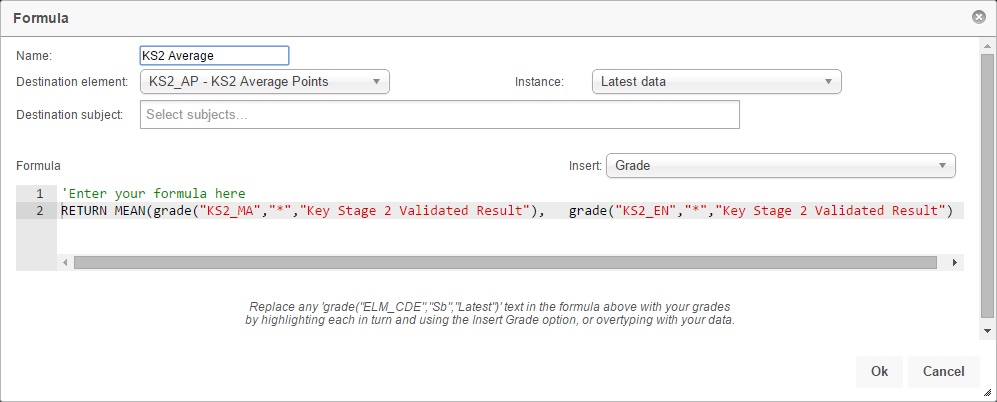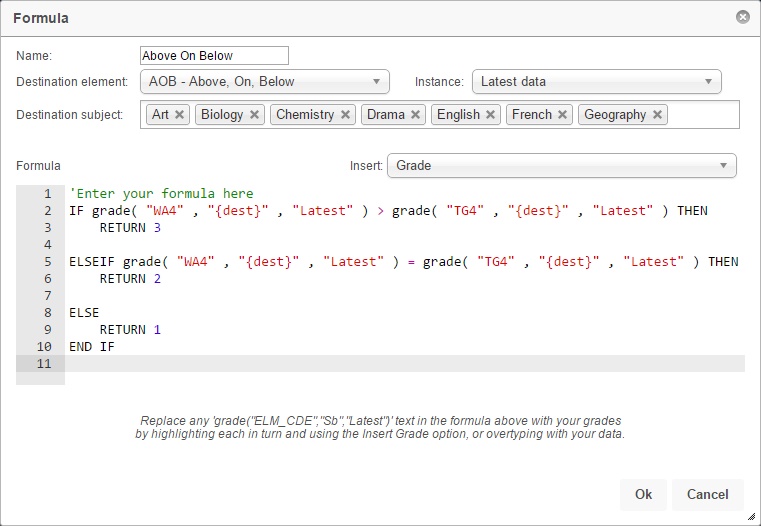Grade calculator
| Permissions required to access this module: | |
| Section: | |
| Grading | |
| Permission(s): | |
| Access grading | |
| Configure grading elements | |
The grade calculator is used to generate grades for pupils. You configure a calculation which will perform tests on pupils' grades, and then give more grades to pupils based on the outcomes of these tests. For example, you might create a calculation that finds the average of three grades and then gives pupils a mark depending on how good their average is.
This page is accessed via:
PARS main menu > Grading > Grade calculator
Grade calculator
The grade calculator page
Any calculators that have been configured will appear on this page. For each calculator, you will be able to see the title, which grade element the calculator will write back to, and which subject(s) the calculator will write back to.
Adding and editing calculations
To create a new calculation, click the Add button at the top left of the page. Alternatively you can select an existing calculation and click edit to amend its details. Both of these options will open the formula window. Enter the details of your calculation into the formula window. The various fields available are described below.
Name
- The title of the calculator
Destination elements
- This the grade element that grades will be saved to
Destination instance
- This is the element instance - or result set if using SIMS grades - that the grades will be saved back to
Destination subject
- This is the subject that grades will be saved back to
Insert
- Variable - Grade
- Use this to choose a grading element. When the calculation runs, it will find out what grade the pupil has in the element and use the value of the grade in the calculation
- Variable - Grade
- Structure - Condition
- This will insert an IF THEN ELSE conditional statement into the calculator
- Structure - Condition
- Structure - Case
- This will insert a SELECT CASE statement into the calculator
- Structure - Case
- Function - Mean
- This will convert several numbers into an average value
- Function - Mean
- Function - Maximum
- This will find the maximum from a list of numbers
- Function - Maximum
- Function - Minimum
- This will find the minimum from a list of numbers
- Function - Minimum
- Function - Sum
- This will find the sum of a list of numbers
- Function - Sum
- Function - Product
- This will find the product of a list of numbers
- This will find the product of a list of numbers
- Function - Product
Deleting calculators
To delete a calculation, simply select it and click the Delete button on the top toolbar. This will remove the calculation itself but will not affect any grades.
Running the calculators
Calculations need to be run in order for them to give grades to pupils. Select a calculation and click the Calculate button on the top toolbar. You will then need to select one or more pupils, and the calculation will issue grades to those pupils as appropriate.
Explanation of the code used for formulae
The calculator works a lot like a flowchart; it performs one step at a time until it hits the word "RETURN", which tells the calculator that it needs to save a grade for the pupil it is currently dealing with and then move on to the next pupil. The word RETURN must always be followed by a value, which is the grade that the calculator needs to save.
Every grade has a points score which can be found either in the grade scheme for PARS elements, or in the Grade Set for SIMS aspects. based on their points score. The calculator will handle all grades using their points scores. For example the grade calculator does not know what A* is! if you want the calculator to give a pupil an A* grade, it would need to return 58. If you return a number that does not exactly match one of the grades in the grade scheme, then the calculator will use the closest grade i.e. returning 52 would result in an A grade.
Structure
The calculations are created using very basic programming; the two programming statuses that are used are Condition and Case.
Condition
A condition is an IF THEN ELSE statement, also known as a conditional statement. This works by performing a test (e.g. is Working At grade better than Target grade) and if the test is successful, something will happen (e.g. give the pupil an "above target" grade). If the test is not successful, then either perform another test (e.g. is the Working At grade the same as the Target grade) or just give the pupil a different grade.
This example is represented in flow chart below. This is exactly the same way that the conditional statement will work:
In the grade calculator, the condition statement is written as:
IF (1st test) = (passed) THEN
RETURN (1st result)
ELSEIF (2nd test) = (passed) THEN
RETURN (2nd result)
ELSE
RETURN (3rd result)
END IF
Case
The case statement is very similar to the condition statement. A case statement performs one test and then performs different actions based on what the result it. Case statements are simpler than condition statements, but also less flexible because they can only perform one test.
Below is an example of a case statement. Notice that the diamond boxes are always performing the same test but are looking for a different result.
The case statement will be written as:
SELECT CASE (test)
CASE (test value 1)
RETURN (1st result)
CASE (test value 2)
RETURN (2nd result)
CASE (test value 3)
RETURN (3rd result)
CASE ELSE
RETURN (4th result)
END SELECT
Variables
Variables are things which could vary for different pupils, such as the grade that a pupil has in a grading column; each individual grading column contains multiple different grades. When a calculation runs, it will find the correct value from the variable for each pupil.
The grade calculator will analyse pupils' existing grades. In order to do this, the calculation needs to know which grades it should be analysing. In order to reference a pupil's grade in a calculation, you should select the Grade option from the Insert drop down. This will open a window where you can specify the grade element, instance and subject you wish to use.
Choose a grading element from the list of source elements. If you select a PARS element then you can choose either the "latest data" (which is the most recently entered grades) or one of the instances that have been configured via key indicators. If you selected a student review element then you can select either "latest data" or one of the result sets linked to the element.
If you have selected a PARS element then you need to also choose a subject that the grades will be saved into. If your calculation is saving grades into a PARS Student Review element, then you need to choose one or more subjects that grades will be saved into. In this case you can select "Track destination", and the calculation will get the grades from the same subject it is saving to.
Functions
Functions will take multiple values (such as grades) and give back one value for the calculation. For example, you might want to find the average of 3 different grades, of the highest of 5 grades.
The available functions are:
- Mean
- Maximum
- Minimum
- Sum
- Product
Select the function you want to use from the dropdown and it will be inserted. Each of the functions use the following format:
FUNCTION( value1, value2, value3 )
For example you could insert the following:
MEAN( 10, 20, 30 )
Examples
Below are two examples of grade calculations.
Average of KS2 Maths and KS2 English
This example will use two imaginary SIMS elements; KS2 English & KS2 Maths. The calculator will return the average of the two grades for each of the pupils.
| Element name | Code | Result set |
| KS2 Maths | KS2_MA | Key Stage 2 Validated Result |
| KS2 English | KS2_EN | Key Stage 2 Validated Result |
Note that SIMS elements are not linked to subjects, so the subject select for each of the elements is: "*".
Above, On or Below Target
This example will compare two Student Review elements, Working At and Target. The calculation will give pupils a score which equates to one of three grades; Above Target, On Target or Below Target.
|
|
Note that the subject for each of the grades is "{dest}". This is because the calculation uses Student Review elements, which can be linked to multiple subjects. This calculation is intended to run for multiple subjects, so when it is saving grades to Art, it will use the Art Working At grade and the Art Target grade. When it is running for Biology it will use the Biology Working At grade and the Biology Target grade, etc.
